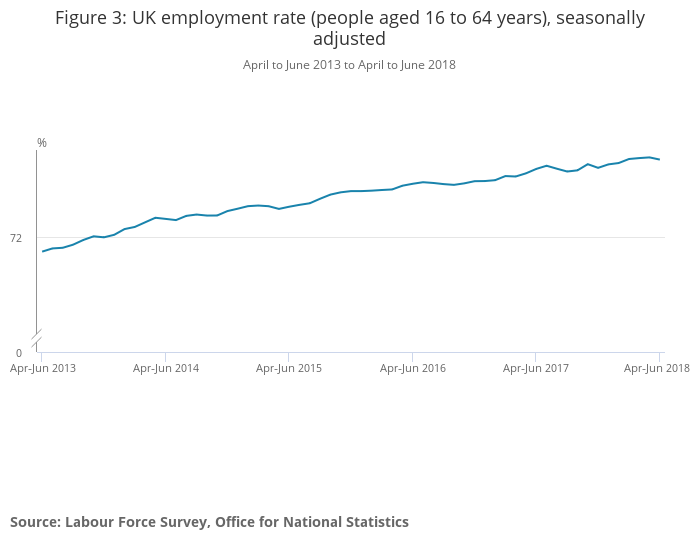
“The number of people in work has continued to edge ahead, though the employment rate was unchanged on the quarter. However, the number of vacancies is a new record high, while the unemployment rate is now at its lowest since the winter of 1974-75.”
“For the first time since the ONS started tracking ‘zero-hours’ contracts, we’ve seen a substantial fall in the number of people on one in their main job.”
“The growth in employment is still being driven by UK nationals, with a noticeable drop over the past year in the number of workers from the so-called ‘A8’ eastern European countries in particular.”
The Laour Force Survey:
Estimates from the Labour Force Survey show that, between January to March 2018 and April to June 2018, the number of people in work increased, the number of unemployed people decreased but the number of people aged from 16 to 64 years not working and not seeking or available to work (economically inactive) increased.
There were 32.39 million people in work, 42,000 more than for January to March 2018 and 313,000 more than for a year earlier.
The employment rate (the proportion of people aged from 16 to 64 years who were in work) was 75.6%, unchanged compared with January to March 2018 but higher than for a year earlier (75.1%).
There were 780,000 people (not seasonally adjusted) in employment on “zero-hours contracts” in their main job, 104,000 fewer than for a year earlier.
There were 1.36 million unemployed people (people not in work but seeking and available to work), 65,000 fewer than for January to March 2018 and 124,000 fewer than for a year earlier.
The unemployment rate (the number of unemployed people as a proportion of all employed and unemployed people) was 4.0%; it has not been lower since December 1974 to February 1975.

There were 8.73 million people aged from 16 to 64 years who were economically inactive (not working and not seeking or available to work), 77,000 more than for January to March 2018 but 31,000 fewer than for a year earlier.
The economic inactivity rate (the proportion of people aged from 16 to 64 years who were economically inactive) was 21.2%, higher than for January to March 2018 (21.0%) but slightly lower than for a year earlier (21.3%).
Latest estimates show that average weekly earnings for employees in Great Britain in nominal terms (that is, not adjusted for price inflation) increased by 2.7% excluding bonuses, and by 2.4% including bonuses, compared with a year earlier.
Latest estimates show that average weekly earnings for employees in Great Britain in real terms (that is, adjusted for price inflation) increased by 0.4% excluding bonuses, and by 0.1% including bonuses, compared with a year earlier.
ABC Comment: Have your say below:

1 comment
Leave a comment
Make sure you enter all the required information, indicated by an asterisk (*). HTML code is not allowed.
Join
FREE
Here










